Pumped Hydro Storage: A Clean Solution for Canada’s Energy Future
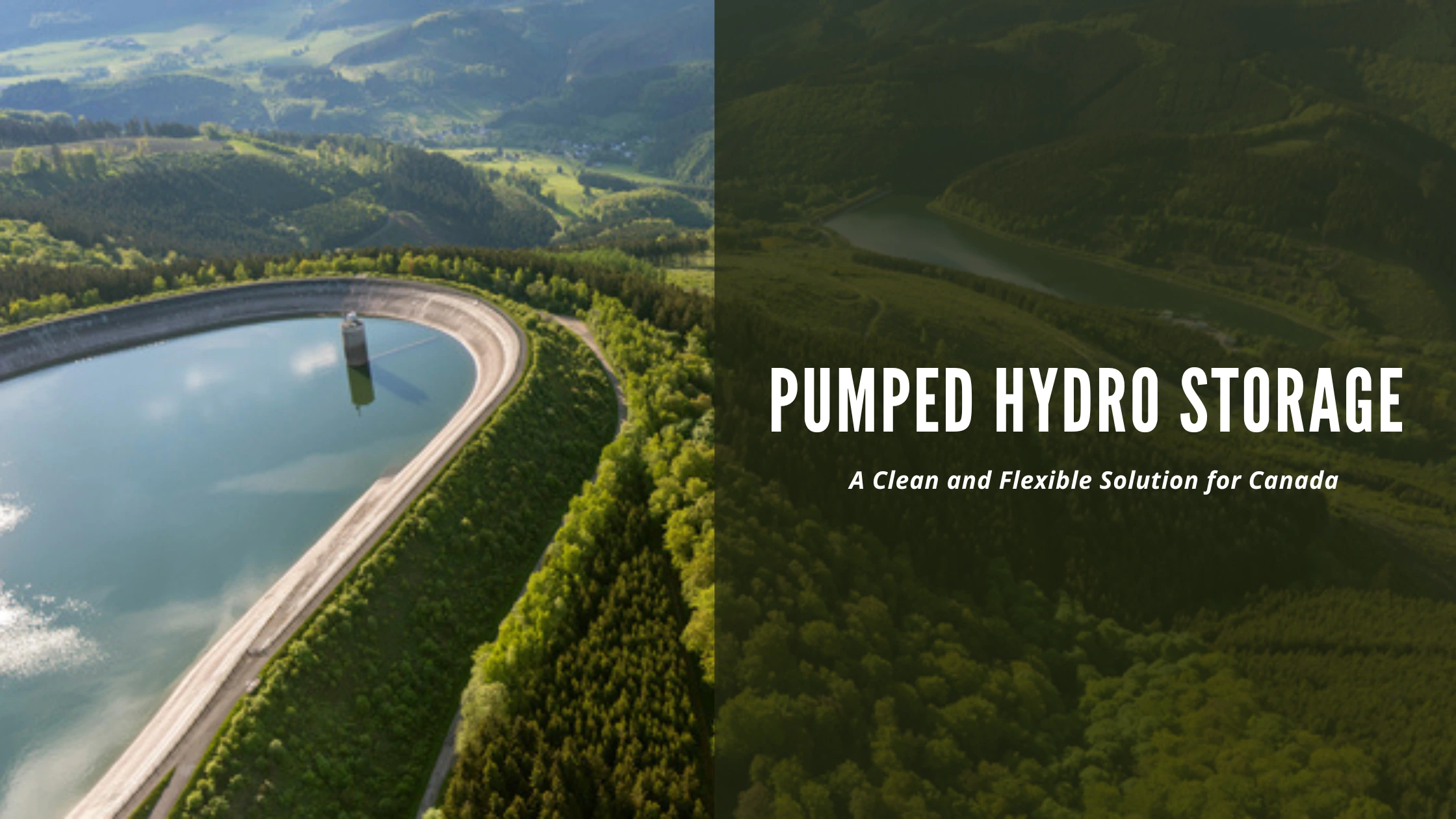
Pumped Hyrdo Storage in Canada
Canada is a world leader in renewable energy, with more than 80% of its electricity coming from sources that do not emit greenhouse gases, such as hydro, wind, solar, and nuclear. However, as the demand for electricity grows and the share of variable renewables increases, the need for reliable and cost-effective energy storage also becomes more urgent. Energy storage can help balance the supply and demand of electricity, enhance grid stability and reliability, and reduce carbon emissions by displacing fossil fuels.
Canada has a rich potential for Pumped Hydro Storage (PHS) development, with abundant water resources and suitable topography. According to a recent report by Stantec, Canada has over 8,000 gigawatts (GW) of PHS potential at almost 1,200 site locations, mostly in British Columbia, Quebec, and Newfoundland and Labrador. (Stantec Completes Report on Pumped Storage Hydropower Potential for WaterPower Canada, n.d.) However, Canada currently has only two operating PHS facilities, with a combined capacity of 1.8 GW: the Sir Adam Beck Pump Generating Station in Ontario and the Mica Dam in British Columbia.
This reports aims to provide an overview of Pumped Hydro Storage technology and its benefits, as well as to highlight some of the current and planned PHS projects in Canada, with a focus on the Ontario Pumped Storage Project (OPSP) in Meaford and the Sir Adam Beck Pump Generating Station in Niagara Falls.
How PSH Works
PHS is a simple and efficient way of storing and generating electricity using water and gravity. The basic principle of PHS is to pump water from a lower reservoir to a higher reservoir during periods of low electricity demand and low electricity prices, and then release the water back to the lower reservoir through turbines to generate electricity during periods of high electricity demand and high electricity prices. This way, Pumped Hydro Storage acts like a giant battery that can store electricity when it is abundant and cheap, and deliver it when it is scarce and expensive.
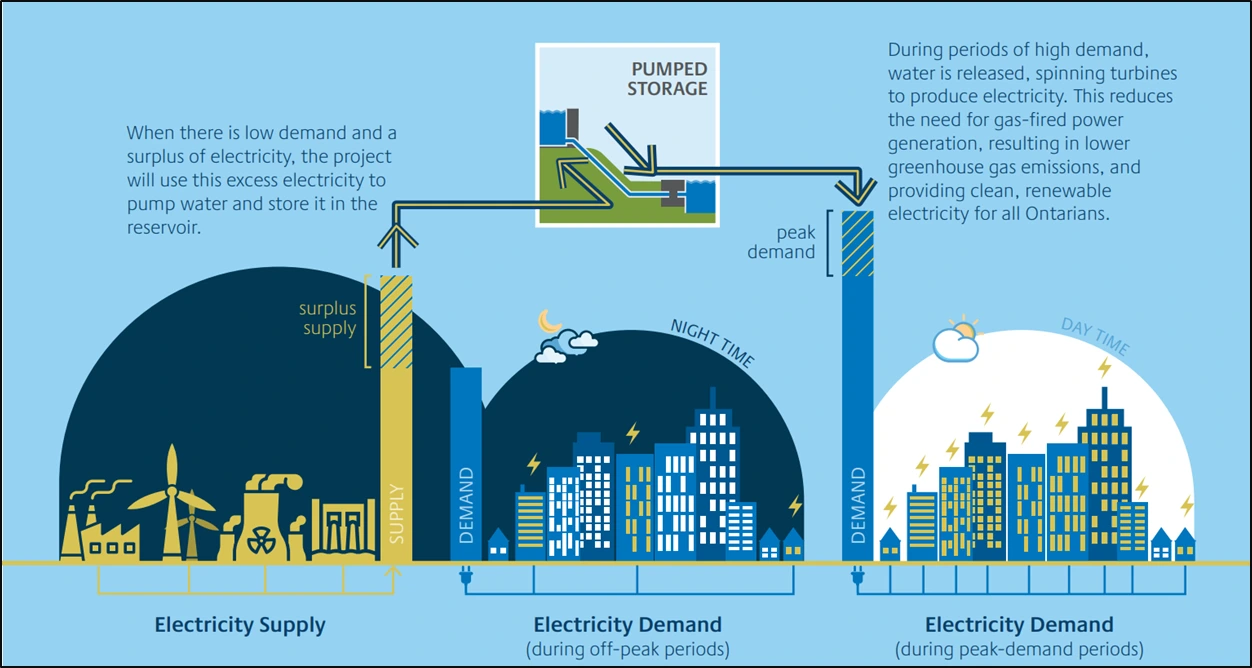
The key components of a PHS plant are:
- Two reservoirs at different elevations, which can be natural or artificial, such as lakes, rivers, or mine pits.
- A powerhouse, which houses the pump-turbines and generators that convert mechanical energy to electrical energy and vice versa.
- A waterway, which connects the reservoirs and the powerhouse, and can be a canal, a tunnel, or a pipe.
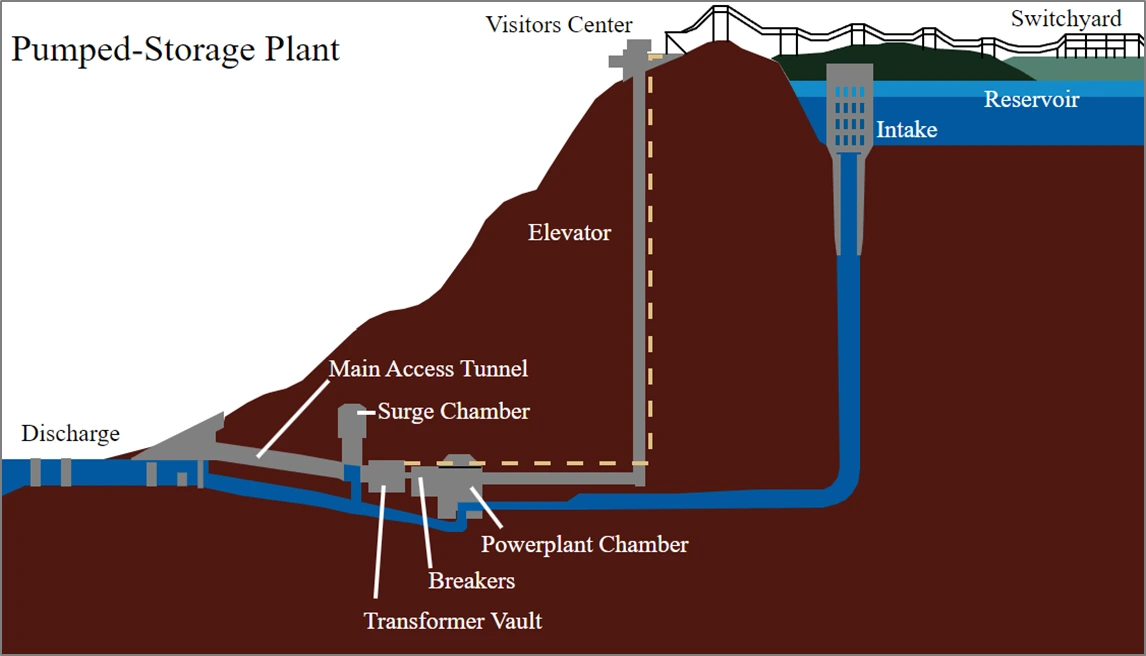
The efficiency of a Pumped Hydro Storage plant depends on several factors, such as the head difference between the reservoirs, the distance and diameter of the waterway, the type and number of pump-turbines and generators, and the losses due to friction, leakage, and evaporation. The typical round-trip efficiency of a PHS plant ranges from 70% to 85%, meaning that for every 100 kilowatt-hours (kWh) of electricity used to pump water, 70 to 85 kWh of electricity can be generated by releasing water. ("Pumped-storage hydroelectricity", 2024)
Types of PSH Plants
There are two main types of PHS plants, depending on the configuration of the reservoirs and the waterway:
Open-Loop PHS:
This is the most common type of Pumped Hydro Storage, where the lower reservoir is connected to a natural water body, such as a river or a lake, and the upper reservoir is either natural or artificial. The water level in the lower reservoir varies depending on the natural inflow and outflow, as well as the pumping and generation cycles. An example of an open-loop PHS plant is the Sir Adam Beck Pump Generating Station in Ontario, which uses the Niagara River as the lower reservoir and a man-made reservoir on top of the Niagara Escarpment as the upper reservoir.
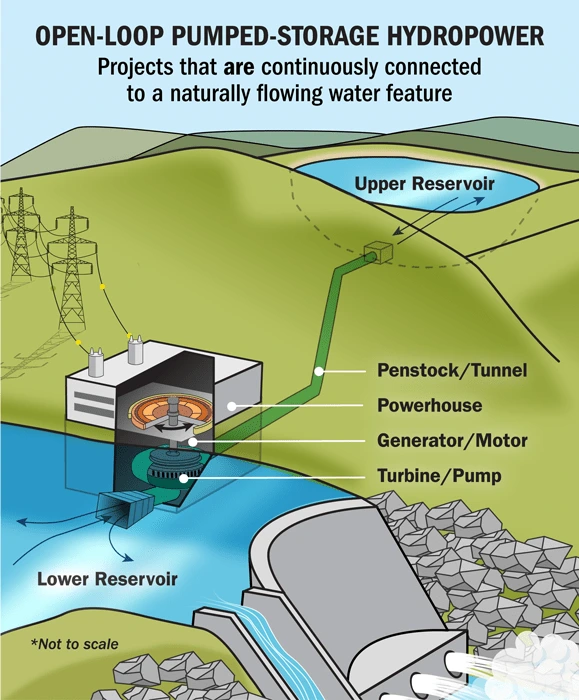
Closed-Loop PHS:
This is a type of PHS where both the lower and the upper reservoirs are artificial and isolated from any natural water body. The water level in both reservoirs is controlled by the pumping and generation cycles, and there is no net consumption or discharge of water. A closed-loop PHS plant can be located in areas where there is no suitable natural water source, such as a mountainous or desert region. An example of a closed-loop PHS plant is the Mica Dam in British Columbia, which uses two artificial reservoirs created by the damming of the Columbia River.
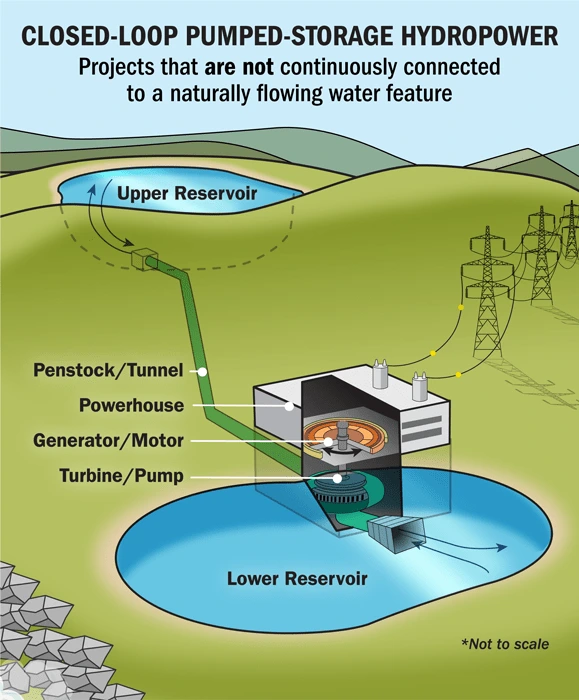
Location and Size of PSH Plants
The location and size of a PHS plant are determined by several factors, such as the availability and suitability of water resources, the topography and geology of the site, the distance and connection to the transmission grid, the electricity market conditions and regulations, the environmental and social impacts, and the economic viability and feasibility.
The availability and suitability of water resources are essential for the operation of a PHS plant, as they affect the amount and quality of water that can be stored and used for pumping and generation. The water resources can be natural or artificial, such as rivers, lakes, reservoirs, or mine pits. The water resources should have sufficient capacity and reliability to meet the desired storage and generation objectives, as well as minimal variability and uncertainty due to seasonal, climatic, or hydrological changes.
The topography and geology of the site are important for the design and construction of a PHS plant, as they affect the head difference between the reservoirs, the length and diameter of the waterway, the type and number of pump-turbines and generators, and the stability and safety of the structures. The site should have a suitable elevation difference between the reservoirs, preferably more than 100 meters, to achieve a high efficiency and power output. The site should also have a suitable distance and alignment between the reservoirs, preferably less than 10 kilometers, to minimize the losses and costs of the waterway. The site should also have a suitable soil and rock composition, preferably hard and homogeneous, to support the weight and pressure of the reservoirs and the waterway, and to prevent leakage, erosion, or landslides.
The distance and connection to the transmission grid are crucial for the integration and operation of a PHS plant, as they affect the power quality and reliability, the grid stability and security, and the market participation and revenue. The PHS plant should be located close to the load centers and the renewable generation sources, preferably within 100 kilometers, to reduce the transmission losses and congestion, and to provide ancillary services, such as frequency regulation, voltage control, and spinning reserve. The PHS plant should also be connected to the transmission grid with adequate capacity and redundancy, preferably with multiple lines and substations, to ensure the power delivery and availability, and to avoid curtailment, outage, or islanding.
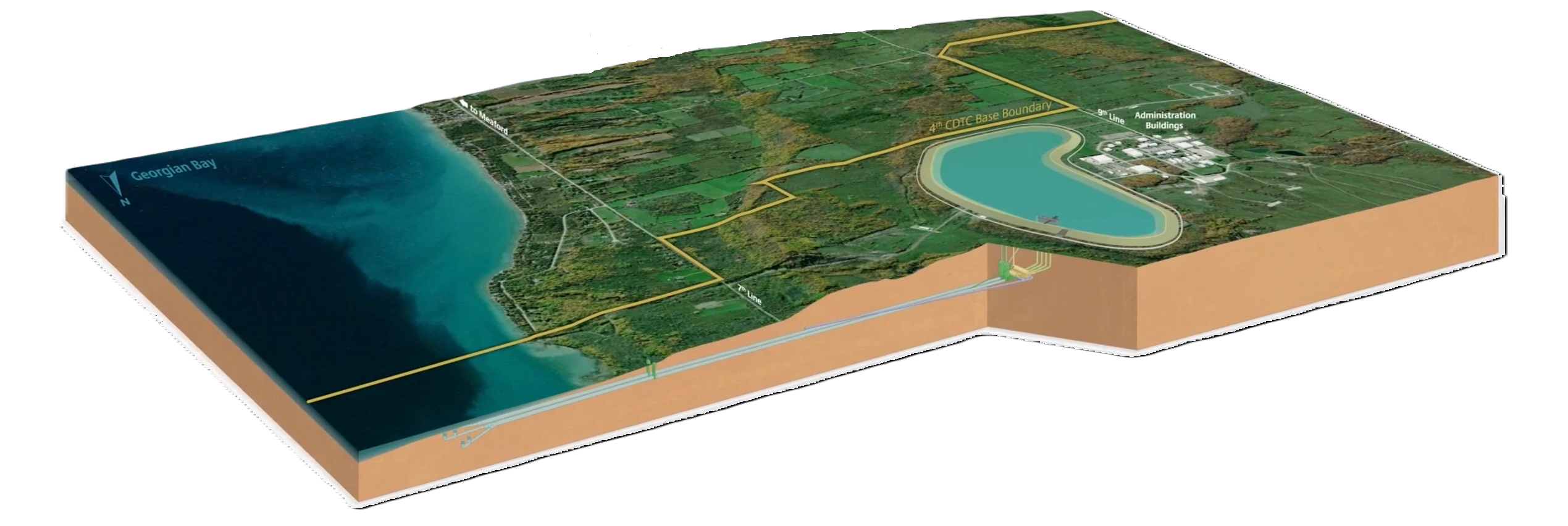
The environmental and social impacts are significant for the assessment and approval of a PHS plant, as they affect the natural and human aspects of the site and the surrounding area, such as the water quality and quantity, the land use and cover, the wildlife and habitat, the cultural and historical heritage, and the public health and safety. The PHS plant should be located in a site that has minimal or manageable environmental and social impacts, or that can provide adequate and acceptable mitigation and compensation measures, such as monitoring and restoration programs, environmental and social impact assessments, stakeholder and community consultations.
Innovative Technologies and Approaches in PHS Generation
PHS is a mature and proven technology, but there are still opportunities for innovation and improvement in various aspects, such as the design and operation of the pump-turbines and generators, the optimization and control of the pumping and generation cycles, the integration and coordination with other renewables and grid services, and the development and application of new materials and methods. Some examples of innovative technologies or approaches in PHS generation are:
Variable Speed PHS:
This is a type of PHS that uses variable-speed pump-turbines and generators, which can adjust their rotational speed according to the grid frequency and the power demand. Variable-speed PHS can provide more flexibility and efficiency than conventional fixed-speed PHS, as it can operate in a wider range of head and flow conditions, and can offer faster and smoother frequency regulation and voltage control.
Underground PHS:
This is a type of PHS that uses underground reservoirs and waterways, such as abandoned mines, caverns, or tunnels, to store and generate electricity. Underground PHS can reduce the environmental and social impacts of PHS, as it can avoid the land use and visual intrusion of surface reservoirs and waterways, and can minimize the water losses due to evaporation. Underground PHS can also increase the security and reliability of PHS, as it can protect the facilities from natural disasters, sabotage, or vandalism.
Use of PHS in the World Energy Mix
PHS is a significant and valuable component of the world energy mix, as it can provide large-scale, long-duration, and flexible energy storage and generation services to the power system. PHS can support the integration and utilization of other renewables, such as wind and solar, by balancing their variability and intermittency, and by enhancing their value and revenue. PHS can also improve the grid stability and reliability, by providing ancillary services, such as frequency regulation, voltage control, spinning reserve, and black start.
According to the International Energy Agency (IEA), the global PHS capacity was 161 GW in 2020, accounting for 94% of the global electricity storage capacity and 3% of the global electricity generation capacity. The top five countries with the largest PHS capacity were China (34 GW), Japan (28 GW), the United States (23 GW), France (13 GW), and Italy (9 GW). The global PHS generation was 1,270 terawatt-hours (TWh) in 2020, accounting for 4% of the global electricity generation and 16% of the global renewable electricity generation. The top five countries with the largest PHS generation were China (313 TWh), the United States (268 TWh), Japan (132 TWh), France (67 TWh), and Germany (44 TWh). (Pumped Storage Hydropower Storage Capability by Countries, 2020-2026 – Charts – Data & Statistics - IEA, n.d.)
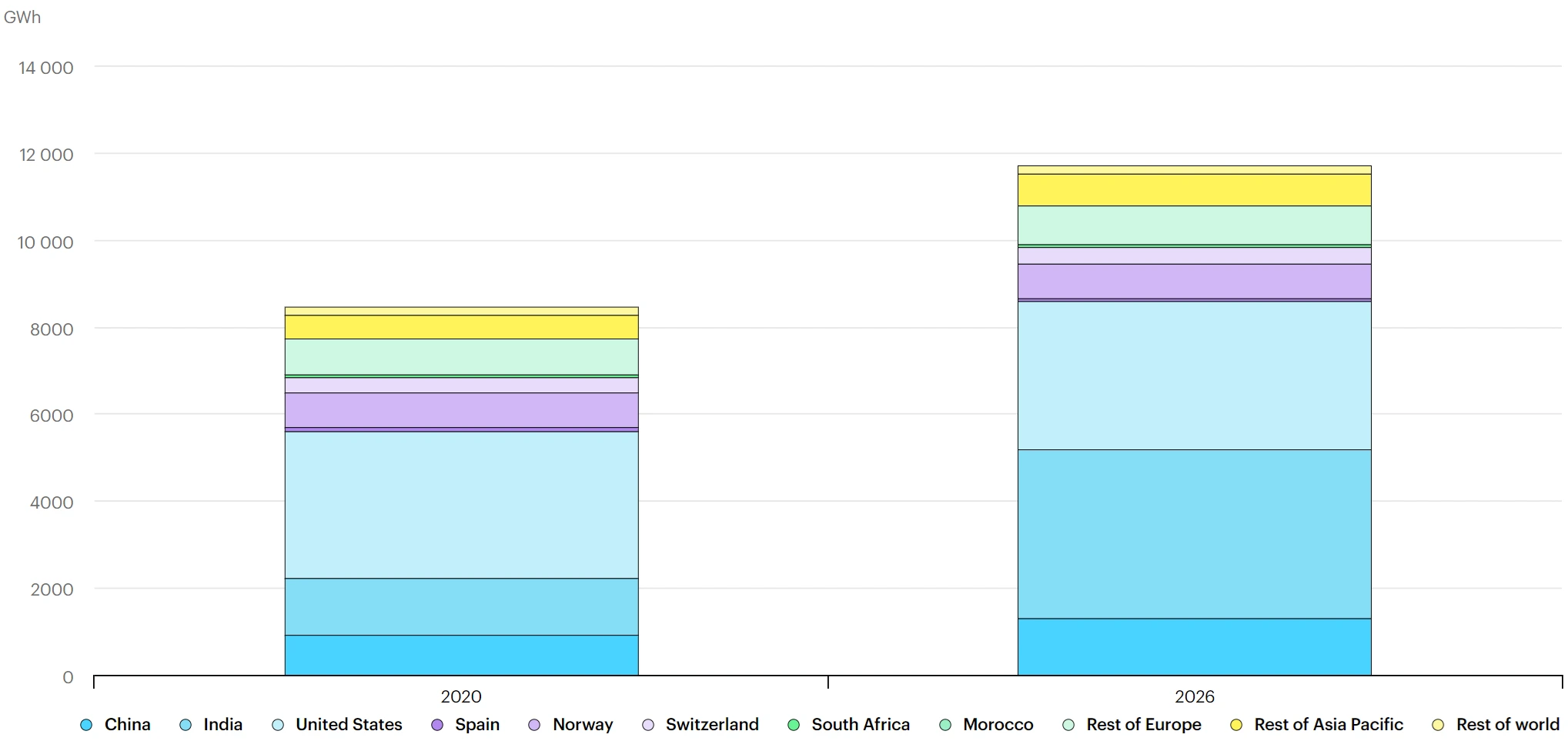
The IEA projects that the global PHS capacity will increase to 181 GW by 2026, with an average annual growth rate of 2.4%.(Pumped Storage Hydropower Storage Capability by Countries, 2020-2026 – Charts – Data & Statistics - IEA, n.d.) The main drivers for the PHS expansion are the increasing demand for electricity storage, the growing share of variable renewables, and the supportive policies and regulations for energy storage. The main challenges for the PHS development are the high capital costs, the long lead times, the environmental and social impacts, and the market and regulatory barriers for energy storage. The IEA also identifies several opportunities for the PHS growth, such as the repowering and retrofitting of existing PHS plants, the hybridization and integration of PHS with other renewables, and the innovation and demonstration of new PHS technologies and approaches.
Conclusion
PHS is a clean and flexible solution for Canada’s energy future, as it can help achieve the goals of decarbonization, electrification, and resilience. Canada has a rich potential for PHS development, with abundant water resources and suitable topography. However, Canada currently has only two operating PHS facilities, and faces several challenges and barriers for PHS expansion. Canada also has some promising opportunities for PHS growth, such as the proposed OPSP in Meaford and the existing Sir Adam Beck Pump Generating Station in Niagara Falls. These projects can showcase the benefits and feasibility of PHS, and can inspire more PHS initiatives across the country.
This report has provided an overview of PHS technology and its benefits, as well as some examples of current and planned PHS projects in Canada. It has also addressed some questions related to the process, types, location, size, innovation, and contribution of PHS.
